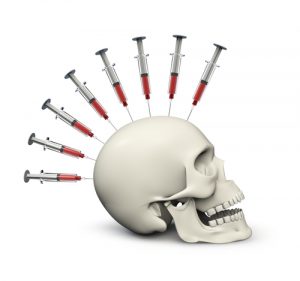Written by Fay Smith
ADHD is a common diagnosis for kids who struggle in school, but what happens when kids grow up and struggle in their offices, communities, and relationships?
Adults with ADHD have difficult challenges, and many turn to drugs and alcohol to cope.
In this article, we’ll look at how and why that is.
How Adults Cope with ADHD
ADHD presents many challenges for adults, but one of the biggest is regularly lacking dopamine.
Dopamine is a neurotransmitter that is largely responsible for the pleasure that you feel when you accomplish something. A sense of accomplishment boosts you and makes it easier to take on your next tasks. For people with ADHD, this doesn’t happen the same way.
Adults with ADHD have a different reward system than neurotypical adults. A normal work routine, including meetings, might be somewhat boring for an office manager who is neurotypical, but it could send someone with ADHD into a spiral.
Without feeling like they are accomplishing anything important to them, and receiving the dopamine boost that goes along with that, it becomes increasingly hard to concentrate.
Having ADHD and needing to do things you don’t want to do and aren’t interested in can be extremely difficult, and even painful.
It’s a process of trying to force your brain to act in ways it doesn’t want to. The result is usually a drop in neurotransmitters and the onset of depression. Up to 53% of people with ADHD also struggle with depression.
There are legal substances that can provide a lot of help to adults with ADHD. Coffee can help to stimulate the brain to produce more neurotransmitters, and legal CBD can help to relax the nervous system and provide the restful sleep that adults with ADHD need to maintain good brain health. Know more about it here.
However, there are many adults with ADHD who turn to alcohol and drugs – not just to cope with the pain of having ADHD as an adult in a world designed for neurotypical people, but to help manage an unruly brain that won’t seem to follow directions.
Why do ADHD Adults Turn to Drugs and Alcohol?
It’s important to note that every adult with ADHD was once a child with ADHD, and it is typically in pre-adolescence or adolescence when substance abuse problems or tendencies first arise.
An 8-year longitudinal study found that at the age of 14.9, 40% of ADHD subjects and only 22% of control subjects had used alcohol (Barkley et al. 1990). This suggests that alcohol and other drugs are more appealing to people with ADHD in early adolescence.
A different study found that at age 25, alcohol use was roughly equal between ADHD adults and control groups, but we know that early and intense alcohol use is a risk factor for later alcohol and drug problems.
Growing up is when most people start to face increasing demands on their time and attention, which is also when young adults with ADHD begin to face significant struggles and shoulder the shame that comes from not being able to act or be like everyone else.
ADHD adults use drugs to cope, practically and emotionally.
In a practical sense, drugs and alcohol change the brain and produce the mental states that people with ADHD are looking for. When you are unable to feel happy or concentrate, a cup of coffee can help. So can other drugs. When you can’t seem to calm down or regulate your energy or emotions, alcohol can help. So can other drugs.
Neurotypical adults might be able to take a deep breath and restore calm and focus, but this just doesn’t happen for ADHD adults, who struggle to regulate themselves.
On an emotional level, it is easy to blame yourself for your problems as someone with ADHD. An inability to focus can be mistaken as a lack of interest or care. Disinterest in boring and unrewarding tasks can come across as laziness.
Adults with ADHD have to deal with a disabling inability to focus, as well as being blamed personally for that inability to focus.
In a culture that values constant productivity and readiness, adults with ADHD often struggle to regulate their attention and emotions and use drugs or alcohol as tools to cope.
Recovery for Adults with ADHD and Drug Problems
Although alcohol and other drugs might relieve temporary symptoms of ADHD, they invariably make life worse.
This is not just for all of the reasons that you’re familiar with – the cost, the health impacts, the social impacts, etc – but also because alcohol and most other drugs are harmful to the brain and end up making symptoms worse in the long run.
A healthy brain releases more neurotransmitters that help focus and attention. An unhealthy brain doesn’t regulate itself well. When you start messing with your brain’s reward system, it makes it even harder to set things right.
If you or someone you know is an adult with ADHD and a drug or alcohol problem, find a treatment solution that also addresses the impacts of ADHD. True recovery requires solutions to multiple problems.
Author Bio: Fay Smith
Fay Smith worked in communications for five years before settling down with her husband. She’s now a mother of two young children and takes care of three lovable Pomeranians. Fay Smith is a regular contributor on various health and wellness sites. She also works as a freelance writer and researcher on wellness topics, such as alternative treatments and CBD.
Please also review AIHCP’s Attention Deficit Consulting certificate program and see if it matches your academic and professional goals. The program in online and independent study and open to qualified professionals.









